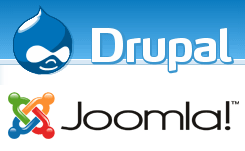Comparing Drupal and Joomla!: A Closer Look at Two Popular CMS Platforms
By Alex Carter on November 1, 2024

When it comes to building and managing websites, the choice of a content management system (CMS) plays a crucial role. Two of the most well-known CMS platforms are Drupal and Joomla!. Both have their strengths and weaknesses, and understanding these can help users select the right system for their needs. This article explores various aspects of these two platforms, including their history, performance, features, and usability.
History and Development
Drupal began as a message board in 2001, evolving rapidly to release its first few versions within a year. By 2002, Drupal reached version 4, with a significant overhaul introduced in version 7 (2011), providing a cleaner and more organized interface. In contrast, Joomla! originated as a branch of the Mambo CMS, releasing its first version in 2005. Its development has been somewhat erratic, with major updates appearing sporadically.
Key Changes in Latest Versions
Both platforms have made significant improvements in their latest versions. Joomla! 2.5 introduced support for multiple databases, expanding beyond its default MySQL. It also added new features like natural language search engine functionality and enhanced user registration notifications. On the other hand, Drupal 7 revamped its database support, integrating SQLite and switching the default MySQL engine to InnoDB, which offers substantial performance improvements.
Performance Considerations
Website performance can be heavily influenced by server configuration and resource allocation. Both Joomla! and Drupal have minimum memory requirements, with Drupal 7 necessitating at least 32MB for a basic install. As sites scale and more modules or extensions are added, this requirement can rise significantly. Bandwidth is another critical factor; web hosts often impose limits that users need to manage carefully to avoid excess usage.
User Management and Permissions
User management has evolved significantly in both platforms. Joomla! introduced Access Control Levels in version 1.6, enabling more granular control over user permissions. With Joomla! 2.5, these controls are even more integrated, allowing for detailed management across the platform. In comparison, Drupal’s user management interface is robust but can be overwhelming due to its complexity. However, Drupal’s permissions system allows for detailed customization and includes features like role assignments, making it powerful for managing different user levels.
Content Management Workflow
Joomla! provides a straightforward content publishing and approval workflow based on user levels, simplifying the process for non-admin users. While Drupal offers similar capabilities, it requires additional configuration and third-party modules for enhanced content management features like versioning. Joomla! allows for easier metadata entry and content display options directly from the content entry screen, while Drupal’s flexibility shines in URL management and custom path creation.
Extending Functionality
Both platforms boast extensive extension ecosystems, with Joomla! having around 9,675 extensions available and Drupal offering over 10,464 modules. While Joomla! extensions can sometimes involve costs or registrations, most Drupal modules are freely available. Drupal has a unique advantage in that popular community modules can eventually become part of its core functionality, which is less common in Joomla!.
Theming and Customization
Theming in Joomla! and Drupal is facilitated by CSS and template management, but the approaches differ. Joomla! utilizes specific tags to define content sections, whereas Drupal relies on div IDs and naming conventions for template overrides. This difference in coding style can impact how easily users can create and manage custom designs. Both platforms support template overrides, but the processes and capabilities differ significantly.
Integration with Other Applications
To integrate with other applications, both CMS platforms can either theme external applications or utilize bridges for database sharing. However, using a bridge can pose security risks, so careful consideration and community feedback are crucial before implementation.
Security
Keeping a CMS updated is vital for maintaining security. Joomla! 2.5 introduced an auto-update feature, improving the ease of maintaining current software. Drupal has offered similar functionality since version 5, enabling users to update modules directly from the admin backend. Regular updates are crucial as they may include important database schema changes that improve security and functionality.
Conclusion
Both Drupal and Joomla! are powerful CMS options, each with unique strengths. Drupal is often favored for its flexibility and robustness in managing complex sites, while Joomla! may appeal more to users looking for ease of use and a straightforward setup. Ultimately, the best choice depends on individual user needs, technical expertise, and specific project requirements.
Posted in blog, Web Applications
Alex Carter
Alex Carter is a cybersecurity enthusiast and tech writer with a passion for online privacy, website performance, and digital security. With years of experience in web monitoring and threat prevention, Alex simplifies complex topics to help businesses and developers safeguard their online presence. When not exploring the latest in cybersecurity, Alex enjoys testing new tech tools and sharing insights on best practices for a secure web.
